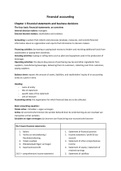Summary
Summary ISE Financial Accounting inclusive college notes
- Module
- Institution
- Book
This is a very comprehensive summary including all the substances discussed: H1-H13 + appendix A. Some subjects may be duplicated in the document, as they have been discussed several times in the book and/or during the lectures. This summary covers all the material for the exam, so you don't need t...
[Show more]




